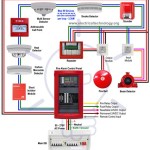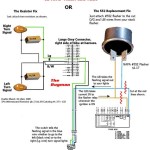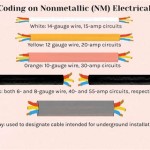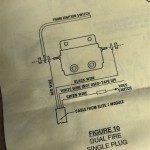Brushless Motor Wiring refers to the electrical connections required to operate a brushless electric motor. It involves connecting the motor’s stator coils to a controller, which provides the necessary power and control signals. A common example of brushless motor wiring is found in electric vehicles, where it enables the efficient and precise operation of the electric motors that drive the wheels.
Brushless motor wiring is crucial as it ensures the proper functioning and control of brushless motors. Its benefits include improved efficiency, reduced maintenance costs, and higher power density compared to brushed motors. A key historical development in this field was the invention of the Hall effect sensor in the 19th century, which revolutionized the detection of magnetic fields and enabled the development of more efficient and compact brushless motors.
This article will delve into the various types of brushless motor wiring, the principles behind their operation, and practical considerations for their implementation in real-world applications.
The essential aspects of brushless motor wiring encompass the fundamental principles, components, and techniques involved in connecting and operating brushless electric motors. Understanding these aspects is crucial for optimizing the performance, efficiency, and reliability of brushless motor systems.
- Wiring Topology: Star, delta, or other configurations.
- Power Electronics: Controllers, drivers, and power supplies.
- Sensor Technology: Hall effect sensors, encoders, and resolvers.
- Motor Construction: Stator windings, rotor magnets, and cooling systems.
- Control Algorithms: Field-oriented control, sensorless control, and commutation techniques.
- Wiring Materials: Copper, aluminum, and insulation.
- Connector Types: High-current connectors, crimping, and soldering.
- EMI Considerations: Shielding, grounding, and filtering.
- Maintenance and Troubleshooting: Diagnosis, fault detection, and repair.
- Safety Standards: UL, CE, and other certifications.
These aspects are interconnected and influence each other, impacting the overall performance of the brushless motor system. Proper wiring design and implementation ensure efficient power delivery, accurate control, and reliable operation. Understanding these essential aspects enables engineers and technicians to optimize brushless motor systems for various applications, from electric vehicles to industrial automation.
Wiring Topology
In the realm of brushless motor wiring, the selection of wiring topology is a critical decision that significantly influences the motor’s performance and efficiency. Wiring topology refers to the arrangement of the stator windings within the motor. The most common configurations are star (Y) and delta (), each with its own distinct characteristics and applications.
The star configuration connects the ends of each stator winding to a common point, forming a neutral point. This topology provides a lower inductance and higher current-carrying capacity compared to the delta configuration. As a result, star-connected motors have a higher starting torque and are generally more efficient at lower speeds. However, they require more conductors and can be more susceptible to ground faults.
In contrast, the delta configuration connects the ends of each stator winding directly to each other, forming a closed loop. This topology results in a higher inductance and lower current-carrying capacity compared to the star configuration. Delta-connected motors have a lower starting torque but can withstand higher voltages and are more efficient at higher speeds. They also require fewer conductors and are less susceptible to ground faults.
The choice between star and delta configurations depends on the specific application requirements. For applications requiring high starting torque and low-speed efficiency, such as electric vehicles and industrial machinery, the star configuration is often preferred. For applications requiring high-speed efficiency and voltage tolerance, such as high-power generators and compressors, the delta configuration is more suitable.
Understanding the relationship between wiring topology and brushless motor wiring is essential for optimizing motor performance and efficiency. By carefully selecting the appropriate topology based on the application requirements, engineers can design and implement efficient and reliable brushless motor systems.
Power Electronics
Within the context of brushless motor wiring, power electronics plays a pivotal role in controlling and supplying the electrical power required for efficient motor operation. Power electronics encompass a range of components, including controllers, drivers, and power supplies, each serving specific functions in the overall system.
-
Motor Controller
The motor controller is the central component responsible for managing the flow of power to the motor. It receives input signals, processes them, and generates the appropriate output signals to drive the motor according to the desired speed, torque, and direction. -
Motor Driver
The motor driver amplifies the output signals from the motor controller and provides the necessary power to drive the motor windings. It acts as an interface between the controller and the motor, ensuring efficient power transfer and protection against overcurrent, overvoltage, and short circuits. -
Power Supply
The power supply provides the electrical power required by the motor controller and driver. It can be a simple DC power supply or a more complex system involving voltage regulation, filtering, and protection circuits. The power supply must meet the voltage and current requirements of the motor and its associated electronics. -
Regenerative Braking
Some motor controllers incorporate regenerative braking capabilities, which allow the motor to act as a generator during deceleration. This feature converts the kinetic energy of the motor into electrical energy, which can be stored in a battery or dissipated as heat.
These components collectively form the power electronics system for brushless motor wiring, enabling precise control, efficient power delivery, and protection of the motor and its associated electronics. Understanding the role and characteristics of each component is crucial for optimizing the performance and reliability of brushless motor systems.
Sensor Technology
Within the intricate domain of brushless motor wiring, sensor technology reigns supreme, providing the crucial information required for precise control and efficient operation. Among the diverse array of sensors employed, Hall effect sensors, encoders, and resolvers stand out as indispensable components, each fulfilling specific roles in the seamless functioning of brushless motors.
-
Hall Effect Sensors
Hall effect sensors utilize the Hall effect to detect the presence and polarity of magnetic fields. In brushless motors, they are typically embedded in the stator and sense the rotating magnetic field generated by the rotor magnets. This information is then used to determine the rotor’s position, enabling commutation and synchronization of the motor. -
Encoders
Encoders provide precise angular position and speed information by converting mechanical motion into electrical signals. In brushless motors, encoders can be mounted on the motor shaft or within the motor housing. They generate a series of pulses that correspond to the motor’s position and speed, allowing for accurate control and feedback. -
Resolvers
Resolvers are electromechanical devices that measure angular position and speed. They consist of a stator and a rotor, with the stator windings excited by an AC voltage. The rotor’s position modulates the induced voltage in the stator windings, providing a continuous and absolute measurement of the angular position.
The judicious selection and implementation of these sensors are paramount for optimizing the performance, efficiency, and reliability of brushless motor systems. Hall effect sensors offer a cost-effective and simple solution for basic position sensing, while encoders provide higher accuracy and resolution. Resolvers excel in applications demanding absolute position measurement and harsh operating conditions.
Motor Construction
Within the intricate web of brushless motor wiring, motor construction stands as a cornerstone, shaping the motor’s performance and efficiency. Stator windings, rotor magnets, and cooling systems are fundamental components that warrant close examination.
-
Stator Windings
The stator windings, typically made of copper wire, are embedded in slots on the stator core. They generate a rotating magnetic field when energized, interacting with the rotor magnets to produce torque. -
Rotor Magnets
Rotor magnets, commonly made of rare-earth materials, are mounted on the rotor shaft. Their interaction with the stator’s rotating magnetic field generates torque, causing the motor to rotate. -
Cooling Systems
Cooling systems are crucial for dissipating heat generated by the motor during operation. They can be air-cooled, water-cooled, or a combination of both. Effective cooling ensures optimal motor performance and longevity.
The interplay between these components is critical. Stator windings determine the motor’s power and efficiency, while rotor magnets influence torque and speed characteristics. Cooling systems ensure that the motor operates within safe temperature limits. By carefully considering these factors during brushless motor wiring, engineers can optimize motor performance, efficiency, and reliability for a wide range of applications.
Control Algorithms
Within the intricate tapestry of brushless motor wiring, control algorithms serve as the maestro, orchestrating the seamless operation and efficient energy utilization of the motor. These algorithms encompass a diverse range of techniques, including field-oriented control, sensorless control, and commutation techniques, each playing a vital role in extracting optimal performance from the motor.
-
Field-Oriented Control
Field-oriented control (FOC) is a sophisticated algorithm that transforms the motor’s complex three-phase AC currents into a simpler two-phase DC representation. This transformation enables precise control of the motor’s magnetic field, resulting in improved torque and efficiency, particularly at low speeds. -
Sensorless Control
Sensorless control algorithms eliminate the need for physical sensors to determine the rotor’s position. Instead, they rely on mathematical models and advanced signal processing techniques to estimate the rotor’s position and speed. Sensorless control simplifies motor design and reduces costs, but it may compromise accuracy and performance at low speeds. -
Commutation Techniques
Commutation techniques are responsible for switching the current in the motor’s windings in a synchronized manner with the rotor’s position. This precise switching ensures that the motor’s magnetic field rotates smoothly, generating continuous torque. Various commutation techniques exist, each with its own advantages and disadvantages, such as trapezoidal commutation and sinusoidal commutation. -
Advanced Control Techniques
Beyond the fundamental algorithms mentioned above, advanced control techniques such as adaptive control, predictive control, and fuzzy logic control are employed to enhance the motor’s performance further. These techniques can improve efficiency, reduce torque ripple, and mitigate disturbances, enabling the motor to adapt to changing operating conditions.
The judicious selection and implementation of these control algorithms are critical for optimizing the performance, efficiency, and reliability of brushless motor systems. By carefully considering the application requirements, engineers can harness the power of these algorithms to design and operate brushless motors that meet the demands of a wide range of applications, from electric vehicles to industrial automation systems.
Wiring Materials
In the realm of brushless motor wiring, the choice of wiring materials plays a crucial role in determining the overall performance and efficiency of the motor. The primary materials used are copper, aluminum, and insulation, each with its unique characteristics and implications.
-
Conductor Material
Copper and aluminum are the two primary conductor materials used in brushless motor wiring. Copper offers superior conductivity, higher current-carrying capacity, and better heat dissipation compared to aluminum. However, it is also more expensive and heavier. -
Insulation Material
Insulation materials are vital for preventing electrical shorts and maintaining the integrity of the motor windings. Common insulation materials include enamel, varnish, and heat-shrink tubing. The choice of insulation depends on factors such as temperature resistance, voltage rating, and mechanical strength. -
Cable Construction
Brushless motor windings can be configured in various ways, such as single-strand wires, twisted pairs, or braided cables. The cable construction influences the flexibility, durability, and electrical properties of the wiring. -
Wire Gauge
The wire gauge, measured in AWG (American Wire Gauge), determines the cross-sectional area and current-carrying capacity of the wire. Selecting the appropriate wire gauge is crucial to ensure sufficient current flow and minimize power losses.
The selection of appropriate wiring materials for brushless motor wiring requires careful consideration of factors such as cost, weight, efficiency, and operating conditions. By choosing the right materials and implementing them correctly, engineers can optimize the performance, reliability, and lifespan of brushless motor systems.
Connector Types
In the realm of brushless motor wiring, connector types play a critical role in ensuring reliable and efficient power transmission. High-current connectors, crimping, and soldering are essential techniques and components that contribute to the effective operation of brushless motors.
High-current connectors are designed to handle the high currents and voltages required by brushless motors. These connectors are typically made of copper or aluminum alloys and feature large contact surfaces to minimize resistance and heat generation. Crimping is a process of mechanically securing the connector to the wire by deforming the connector around the wire strands. This creates a gas-tight connection that ensures good electrical contact and prevents the connector from loosening over time. Soldering is another method of connecting wires to connectors, where a molten metal alloy is used to form a permanent bond between the two. Soldering provides a strong and reliable connection, but it requires more skill and specialized equipment compared to crimping.
The choice of connector type depends on the specific application and requirements. Crimping is a more cost-effective and efficient method for high-volume production, while soldering is often preferred for applications requiring a more secure and permanent connection. Understanding the different connector types and their advantages and disadvantages is essential for selecting the most appropriate solution for brushless motor wiring.
Inverter drives and electric vehicle powertrains are notable examples of practical applications where high-current connectors are used in brushless motor wiring. These applications require reliable and efficient power transmission to ensure optimal motor performance and safety. Proper selection and implementation of connectors, crimping, and soldering techniques are crucial for minimizing power losses, preventing overheating, and ensuring the longevity and reliability of brushless motor systems.
EMI Considerations
In the context of brushless motor wiring, EMI (electromagnetic interference) considerations play a critical role in ensuring the reliable and efficient operation of the motor. EMI refers to the emission and susceptibility of electromagnetic energy, which can disrupt the motor’s control signals and cause performance degradation or even damage to the motor components.
-
Shielding
Shielding involves enclosing the motor and its wiring in a conductive material, such as metal, to prevent the emission or reception of electromagnetic interference. This helps to protect the motor from external EMI sources and minimize the motor’s own EMI emissions. -
Grounding
Grounding provides a low-resistance path for electrical current to flow back to the power source, preventing voltage spikes and reducing the risk of electrical shock. Proper grounding of the motor and its wiring ensures that EMI is safely discharged and does not interfere with the motor’s operation. -
Filtering
Filtering involves using passive components, such as capacitors and inductors, to suppress EMI at specific frequencies. Filters can be placed on the motor’s power supply and control lines to prevent conducted EMI from entering or leaving the motor. -
Twisted Pair Cabling
Twisted pair cabling is a type of wiring that uses two conductors twisted together to reduce electromagnetic interference. This technique helps to cancel out the electromagnetic fields generated by each conductor, reducing the overall EMI emissions and improving the signal quality.
Addressing EMI considerations in brushless motor wiring is crucial for maintaining optimal motor performance, preventing malfunctions, and ensuring the safety and reliability of the system. By implementing proper shielding, grounding, and filtering measures, engineers can minimize the impact of EMI and enhance the overall efficiency and lifespan of brushless motors.
Maintenance and Troubleshooting
In the realm of brushless motor wiring, maintenance and troubleshooting are critical aspects that ensure the reliable and efficient operation of the motor. This involves a range of activities, from preventive maintenance to fault diagnosis and repair.
-
Fault Detection
Fault detection is crucial for identifying potential issues before they lead to major failures. This can be done through regular monitoring of the motor’s performance parameters, such as temperature, current, and speed. Advanced techniques like vibration analysis and acoustic emission monitoring can also be employed to detect early signs of problems.
-
Diagnostics
Once a fault is detected, proper diagnostics are essential to determine the root cause. This involves analyzing the symptoms, reviewing maintenance records, and performing tests to isolate the faulty component or connection. Accurate diagnostics help in implementing targeted repairs and prevent unnecessary replacements.
-
Repair and Replacement
Once the faulty component is identified, it needs to be repaired or replaced. This may involve replacing damaged wires, connectors, or motor windings. Proper repair techniques and high-quality replacement parts are crucial to ensure the restored motor’s performance and longevity. Preventive maintenance, such as regular cleaning and inspection, can help reduce the frequency of repairs.
-
Testing and Verification
After repairs are made, thorough testing and verification are necessary to ensure that the motor is functioning correctly. This involves running the motor under various loads and conditions to validate its performance and safety. Proper testing protocols and documentation help maintain a record of the motor’s condition and facilitate future troubleshooting.
Effective maintenance and troubleshooting practices are essential for maximizing the lifespan, reliability, and safety of brushless motors. By implementing proactive monitoring, accurate diagnostics, timely repairs, and rigorous testing, engineers and technicians can minimize downtime, prevent catastrophic failures, and ensure the efficient operation of brushless motor systems.
Safety Standards
Within the realm of brushless motor wiring, safety standards play a paramount role in ensuring the safety and reliability of electrical systems. UL (Underwriters Laboratories) and CE (Conformit Europenne) are two prominent safety certification organizations that establish rigorous standards for electrical products, including brushless motors and their wiring.
Adhering to these safety standards is critical for brushless motor wiring as it helps to prevent electrical hazards, fires, and other safety concerns. UL and CE standards provide guidelines for various aspects of brushless motor wiring, including wire insulation, conductor size, connector types, and overall system design. By meeting these standards, manufacturers can ensure that their products are safe for use in a wide range of applications.
Real-life examples of safety standards in brushless motor wiring can be found in industries such as automotive, industrial automation, and consumer electronics. Electric vehicles, for instance, rely on high-power brushless motors for propulsion, and these motors must meet stringent safety standards to ensure the safety of passengers and the vehicle itself. Similarly, in industrial settings, brushless motors are used in machinery and robotics, where adherence to safety standards is crucial to prevent accidents and protect workers.
Understanding the connection between safety standards and brushless motor wiring is essential for engineers, technicians, and end-users alike. By adhering to these standards, manufacturers can produce safe and reliable products, while users can have confidence that the electrical systems they are working with meet the highest safety requirements. Furthermore, compliance with safety standards can facilitate market access, as many countries and regions require products to meet specific safety certifications before they can be sold or used.








Related Posts








